The signal chain are as follows:
Guitar — > Distortion FX gear — > (unbalanced high impedance input) — > DI box — > (balanced, low impedance output — > Audio Interface Preamp input — > USB — > Computer
The most critical piece of gear when you are recording direct to your audio interface is the DI box. This will convert the unbalanced high impedance output of your guitar to balanced/low impedance suitable for your audio interface inputs.
If you don’t have a DI, you can buy one as they are not relatively expensive yet very useful in home studio applications. You can find some good DI box such as Pyle-Pro PDC21.
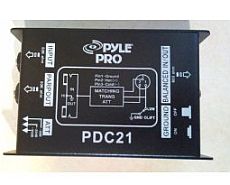
Balanced inputs and outputs are commonly done using XLR to XLR balanced cables. This is done when connecting to your audio interface.
Method #3: Recording Clean Guitar and implementing Re-amping
This is another concept of recording distorted guitar which is also very popular in modern rock recording studios. The first step is to record the guitar as clean as possible without any effects. This is the signal flow path:
Electric guitar — > DI box — > Audio Interface — > Computer
Or if your audio interface supports instrument level inputs such as Focusrite Saffire Pro 40 audio interface, then you can connect your guitar directly without DI:
Electric guitar — > Instrument level input (audio interface)
For more details about instrument level inputs, etc. find out in this tutorial.
Then after recording, the clean guitar is then captured in your DAW and saved in your computer hard drive.
You can then playback the clean guitar recording from your DAW to output that to your audio interface line outputs and finally to a distortion effects processor via the re-amping device. Then record it back to your computer with the captured distorted effects. This process is called re-amping. The signal chain are as follows:
Computer/DAW — > Audio interface line outputs — > Reamping Device(e.g. ProRMP Studio Re-Amper–> Distortion pedal or Hi-z inputs of your Guitar amplifier — > Microphones (SM57) — > Audio Interface inputs — Back to DAW/Computer
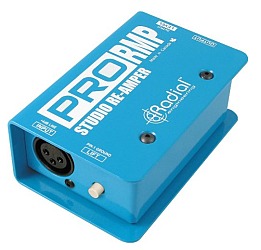
Above is an example of a re-amping device. This will convert the balanced/line inputs signals to hi-z outputs suitable for your distortion effects pedal or guitar amplifier cabinet. Take note that it accepts only XLR balanced inputs. If the line output of your audio interface is using TRS balanced. Then you need to purchase TRS balanced male to XLR male balanced cable to connect the audio interface output to this re-amping device.
Finally the one that is recorded back to your PC is the guitar sound with effects. The main advantage of this setup is that the producer/engineer will have a lot of time to experiment with different guitar distortion tone without the need of the guitarist to re-performed all the time. For details about re-amping, you can read the next section on overdubbing.
Overdubbing Guitar techniques
If you want to have that heavy-thick distorted sound of your guitar (common in rock music), then one of the reliable technique is “overdubbing”. So what is basically “overdubbing”? In music production, guitar overdubbing is simply doing simultaneous re-recording of the SAME guitar track using DIFFERENT production/recording settings.
For example, if you are using a Laney amp for recording guitars, SM 57 for microphones; Fender guitars and then you record a guitar track. After that recording, you re-record the same guitar track again using the same set of instruments and settings. This is NOT an effective overdubbing technique.
To accomplish effective overdubbing, you need to implement a wide variety of techniques/settings to arrive at a thick and heavy guitar sound. Below are the following tips I can provide:
Technique 1: Using Different Guitar Amps with Different Settings
Different guitar amplifiers have its own unique sound and character. You can record the first rhythm guitar take with one amp and another take using different amplifier with two microphones pointing on the amp; the resulting overdubbed sounds different from if you are using a single amp with varied settings. See the flow below:
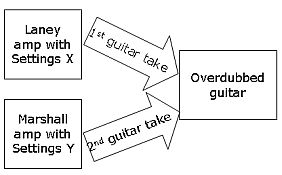
For best results, do more than 2 guitar takes to make the guitar sounds heavier with each take using different amp settings.
Technique 2: One guitar amp using two microphones with varied distance/settings
If you only have one guitar amp at home while having more than one microphone, you can still perform overdubbing. This is how to do it:
1.) First, put two microphones in front of the guitar amp.
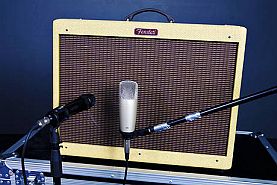
Make sure that the distance between the first and second microphone to the amp is not the same to produce a different tone affected by phase. You can see a video illustration of this technique.
2.) Record the first guitar take.
3.) Adjust first the amp settings to a different sound and then adjusts the distance of one microphone by around 2 to 4 inches farther than before (feel free to experiment).
4.) Record the second guitar take of the same piece.
5.) You can overdub as many times as you want until you attain the desired heaviness.
Technique 3: “Re-amping”
If you want more flexibility during mixing to achieve the desired and optimum guitar tone, you might want to do re-amping. Re-amping works in the following steps:
1.) Recording the guitar dry and clean using DI techniques. This can be done by directly plugging the guitar into the audio interface pre-amp input (no effects placed between the guitar and the audio interface). The recording of guitar performance is only one take which is the best/perfect guitar take as possible.
2.) Once you have recorded a clean guitar tone. This tone is now saved in your hard drive for further processing.

3.) You can now easily overdub them without the need for a guitar player to play over and over again. See the signal flow below on how to do this:

The output of the DAW (from your PC) is then connected to a reamp box which will condition the signal back to the instrument signal level for the guitar effects pedal. The producer or sound engineer can then tweak the effects pedal to the desired settings and then record the performance using a guitar amp with microphones.
To produce overdubs, the producer or sound engineer may wish to re-record several takes using different settings of effects pedal to provide more contrasting layers of guitar sound. Experimenting with the microphone distance (applying the phasing effect) is also possible.
Then the recorded signal from the amp goes back to the audio interface again to be converted to be recorded and saved in your hard drive. The “processed” guitar tone can now be used as one of your overdub tracks. During mixing, the producer may want to overdub the guitar a lot of times. So re-amping is an easy and flexible technique to thicken the guitar sound.
You can read this post on mixing guitars with overdubbing.
Other important factors you need to know
1.) The most popular microphone used for recording overdrive guitars with an amp is SM 57. This is a very versatile microphone that can also be used when recording vocals, bass and even drums.
2.) Be careful of aiming a condenser microphone very close to a loud guitar amplifier cabinet. It is because some condenser microphones are not designed to handle high sound pressure levels. It can damage the microphone.
3.) You can even use the lowest wattage guitar amplifier (such as a practice amp) to fully capture the great overdrive sound. The wattage of the guitar amplifier does not play the role on the capturing quality.
Content last updated on October 23, 2012
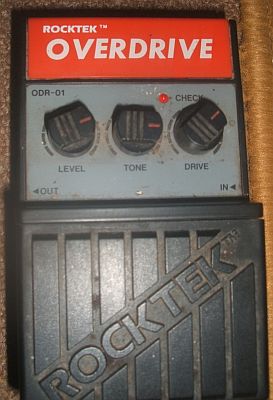








2 Responses
Hello Mon,
If you can make the effect as analog or natural as possible, it sounds much better. So in case, if I have nice sounding outboard analog gears such as guitar distortion pedals, etc I will apply them in tracking. So the path of signal will be (example):
Guitar —> Guitar effects pedal —> mixer/audio interface —> recorded to your computer.
Same thing for reverb and delay. You can experiment which sounds very nice to you and to your song. Cheers!
Hi Emerson,
Me again!
About recording guitars, specifically about reverb/delay effects, do I apply the FX after tracking (on the track) or during tracking? This question applies both to distorted and clean guitars.
thanks again!
Mon